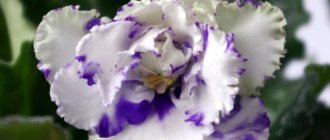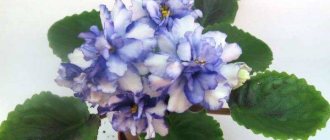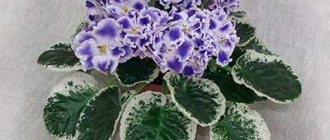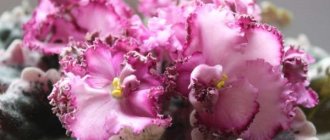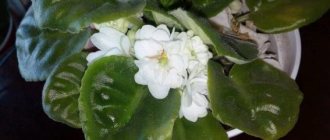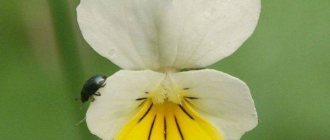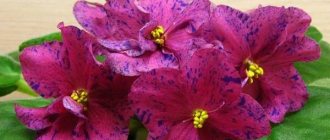Leading masters of violet growing advise beginning flower growers to first choose varieties of violets obtained by breeders of the domestic school to .
Such varieties of exotic beauties
are better adapted to the microclimate of our apartments and are not inferior to foreign varieties in the effectiveness of decorative images.
Of all the variety of varieties, you can pay attention to the gorgeous violet “RM-Blue Drifts” with:
- Terry whisks;
- And gentle tints of shades.
Below you will see a photo of the RM-Blue Drifts violet.
Violet RM-Blue Snowdrifts (N. Skornyakova)
Luxurious violet Blue Snowdrifts.
Authorship of Saintpaulia
The charming Saintpaulia with watercolor transitions in the color scheme of lush buds and the neat structure of the bush was registered as a variety by Kursk breeder Natalya Skornyakova, who:
- He is a representative of the new wave of the domestic school of violet growing;
- And he has been generating varieties of exotic beauties since the beginning of the twenty-first century.
The selection line of N. Skornyakova is dedicated to the master’s mother , Raisa Mikhailovna. Therefore, all varieties are marked with the abbreviation “RM”.
The variety in question was developed by Natalya Skornyakova.
ATTENTION! The variety has been appearing at exhibitions since 2015 and always receives positive feedback from experts and spectators.
Taxonomy of the variety
Taxonomic periodization of botanical objects classifies the violet, according to official hierarchical principles, to the genus Saintpaulia (from the Gesnerieceae family), immense in varietal representation and magnificent in artistic variations:
- According to the average coefficients of bush size characteristics, specimens of the variety are included in the group of the standard section;
- And according to the type of flower density - into a double subspecies.
The variety belongs to the terry subspecies.
Description of decorative features
The variety does not cause any particular difficulties when kept in home collections and is distinguished by its absolutely non-capricious nature of response to methods of agrotechnical care, but for inexplicable reasons it is poorly distributed in the collections of flower growers.
IMPORTANT! Violet specimens are distinguished by their independent behavior during the procedure of laying adult leaf rosettes. This feature of any Saintpaulia variety always attracts the attention of gardeners when choosing a new plant for the collection, as it guarantees savings in their time and effort during the initial development of the specimen.
The beginning of active growth of a young bush is marked by the neat distribution of emerging leaf plates along the serpentine tiers of the rosette in a symmetrical manner according to the architectural rules of tiled alternation of elements relative to each other.
As a result, the gradually maturing Saintpaulia acquires smooth outlines with a spatial texture of a dense degree of filling, in which each section of the plant receives the optimal amount of necessary solar energy.
In terms of the size of its overall structure, the violet represents a section of the standard subspecies - its specimens almost always reach the average numerical indicators of the type. The texture of Saintpaulia is characterized by:
- Consistently compact shapes;
- Aligned contours;
- And mosaic graphics of rosettes.
Medium-sized violet leaves differ:
- Oval shape with an elongated - narrowed tip;
- Quilted texture with a shiny surface;
- A mass of fine fibers;
- Often with an extruded venation pattern;
- And the coloring is in the tonality of summer green.
The contours of the leaf plates are framed by small, smoothly rounded teeth . The leaves themselves have a wavy configuration, due to which they can bend slightly downward or, to some extent, lift the side edges up and thereby increase the spatial volume of the violet.
Saintpaulia has oval-shaped leaves.
Violets that have reached the third or fourth wave of flowering continue to live in the mode of abundant budding:
- Creating a lush hat from the most voluminous blossoming corollas;
- And delighting flower growers with extraordinary color transitions.
Violet flowers, according to the type of their shape, belong to the “star” format , differing:
- Significant volume of dimensions;
- And lush - terry, tight degree of filling of the corollas with petals.
Flowers get an even greater effect of spatial splendor thanks to:
- The dense texture of the fabric of each petal;
- And the wavy structure of their edges.
NOTABLE! The main feature of the violet is the most delicate coloring of its flowers with lyrical notes - soft shades of lilac and blue colors are mixed with the main white color of the petals in an unpredictable and unique manner. The color filling is reminiscent of artists’ watercolor technique, and the density of shades to some extent depends on the microclimate conditions of the room, in particular on temperature indicators. The color spots mostly gravitate towards the central part of the corolla.
Violet blooms with lush, large flowers.
Sports
Saintpaulia has good repeatability of its characteristic varietal characteristics. Only occasionally can a violet bloom for sport , blooming corollas of an even purple color with a slight edging of white.
ATTENTION! In sports specimens, the tonality of the leaves also changes, turning into a shade of dark green.
In this variety you can find sport.
Useful video
Interesting facts in the video about how to independently collect soil for Saintpaulias: Find out in the video how to properly replant and rejuvenate violets: Watch the video when it is necessary to water Saintpaulias: Video instructions for applying fertilizers for violets:
Care techniques in indoor culture
The violet is not a flower “whim” - it responds gratefully to regular and careful implementation of simple agrotechnical measures :
- The plant should be placed on a window facing west or east; specimens from windows to the north should be provided with additional rays with a diffuse spectrum, to the south - unobtrusive artificial protection is required;
- Watering is indicated in small doses from the moment when slight drying of the upper volume of the substrate is visually clearly visible;
- Apply additional fertilizing with mineral fertilizers best of all, focusing on the state of the bush’s decorativeness;
For good flowering, violets require fertilizing. - Provide light primarily during the day, long-lasting, with a spectrum of scattered rays;
- Control a constant heat level within +20 + 24°C ; eliminate sudden fluctuations in the temperature gradient;
- Plant the rosette in nutritious, permeable soil with good aeration; ensure the creation of a volumetric drainage layer;
- When transplanting , use transshipment more often if there are no special indications.
Distinctive features
Lebetskaya varieties are distinguished by abundant flowering in the early stages . Breeder's violets with graceful compact rosettes surrounded by emerald green or variegated foliage.
IMPORTANT : When choosing a flower for propagation, you need to carefully study the rules for caring for the species you like. It wouldn’t hurt to visit a couple of forums dedicated to Saintpaulia lovers, ask amateur flower growers, and read specialized literature.
Our specialists have prepared for you a number of materials that contain information about the most talented breeders and the varieties they have bred. Read about the violets of Natalia Puminova, Konstantin Morev, Tatyana Pugacheva, Alexey Tarasov, Evgeny Arkhipov, Boris and Tatyana Makuni, Natalia Skornyakova, Svetlana Repkina, Tatyana Dadoyan and Elena Korshunova.
Reviews
Zhanna Vitalievna. “ The violet “RM-Blue Drifts” has been growing in my collection for the third year now, distinguished by its enchanting flowering, ease of care and very impressive corollas. The petals of the variety have a compacted structure, due to which the double configuration of the flowers is firmly preserved even when the plants are transported to exhibitions.”
Saintpaulia attracts flower growers with its unusual color.
Briefly about the breeder Elena Lebetskaya
Attention : The author’s passion can be seen from afar - her garden plot and house are buried in flowers. Most of them are violets. Simple collecting gradually grew into a lifelong pursuit, and now there are more than 400 varieties bred by her hands.
All her “brainchildren” are extremely popular not only in Ukraine and Russia, but also in neighboring countries. The only variety in the world, Leons Yarly Spring, with huge snow-white stars, was bred by her and received a prize at the first All-Ukrainian competition and the approval of the audience. Her violets have twice received the title of “best violets of Ukraine” - “Sultry Summer” and “Impresario”. Lebetskaya varieties are marked with the prefix LE .
A detailed look at the life stages of Saintpaulia
The vital activity rhythms of violets for the most part correspond in timing to the standard course of biological processes in many tropical beauties of the genus, which significantly alleviates problems when caring for the plant.
The violet grower can simply draw up graphs according to a standard template , adjusting them in accordance with the specific development of the variety.
Specificity of development in indoor collections
From its initial development and with further growth, varietal violet shows itself at its best:
- Without causing trouble;
- Not being picky about microclimate conditions and agrotechnical care techniques;
- And also giving gardeners joy with its stunning blooms.
These positive aspects of the violet’s nature make it an excellent option for any home collection and especially for those new to cultivating these tropical beauties.
Among the positive features of violets, one can point out such useful characteristics as:
- Ability to create a harmoniously designed leaf rosette;
- Rapid growth and development of bushes;
- Simple methods of reproduction;
- Volumetric flowering according to the cap typology with a long stage of decorative flower maturity;
- Spectacular texture of terry corollas;
- Low reaction to minor violations in containment regimes.
Despite the many qualities favorable for indoor plants, violet has only a few negative nuances in its development:
- Slight dependence of color intensity on heat;
- Slight deviation of the sheet plates from their direct position in the socket;
- Gradual increase in flowering characteristics to maximum values.
Growing violet according to timing
Varietal Saintpaulia prepares to flower at a time normal for the genus - this means that it becomes an adult, just like most violets. But the timing of the teenage phase also depends on the method of obtaining young specimens :
- If you use the baby from a leaf cutting, the stage will take approximately eight months after the embryo is laid;
- If you use a stepson grown by the mother's violet, the period will be shortened somewhat.
Features of reproduction
In the arsenal of violet growers who want to obtain young specimens of varietal violets to propagate their favorite variety, there are only vegetative techniques :
- Children from leaf cuttings;
- Stepchildren from the mother plant.
Propagation of violets using seeds is not recommended by experts - in this case, there is a high probability of losing varietal characteristics.
Flower response to temperature
The color tone of flowers depends to some extent on fluctuations in the temperature gradient:
- In a cool room, the shades of color spots on the corollas may become noticeably pale;
- And in the heat, the color “floats”, becoming a thicker color.
CAREFULLY! Violet flowers and buds react extremely strongly to temperature changes and drafts - they fall off when exposed to these negative factors!
Pedicel strength
Violet flower stalks meet all the necessary requirements - they have :
- Durable structure;
- Optimal height;
- And significant strength.
This allows them to calmly hold voluminous flowers in an upright position.
Flowering type
At the first opening of the buds, the violet tries to form a cap-type flowering of large flowers of double texture, but the violet cap reaches its maximum strength and expressiveness only in the third wave of flowering.
Lifespan of a flower
Violet blooms for about a month.
The general flowering of violets occurs over a long period due to the fact that each flower can maintain an attractive decorative appearance for about a month.
Reproduction methods
RM-Pink Wave reproduces well by vegetative means .
Methods:
- Rooting leaf cuttings . The leaf will take root in water, soil, vermiculite;
- kids. They are not formed often, but they take root well; such a plant will bloom faster than one grown from a leaf cutting.
Saintpaulias are most often propagated by leaves.
Sislin's romance
Another success of a foreign selection school. Author - Paul Sorano, 2008.
Description
In terms of the size of the rosette, the violet Sizzlin' Romance (LLG/P.Sorano) belongs to the large standard . The variety forms a rosette with an even contour, but somewhat loose due to the elongated leaf petioles.
The oval leaf plates of large sizes have a dark green tint and a smooth surface. The reverse side of the sheet has a reddish backlight.
Violet blooms as a bouquet . Each elongated peduncle supports more than 10 - 15 buds.
The corollas are medium-sized, semi-double filled, painted with a burgundy-coral color. Each wavy petal is decorated along the contour with dark sparkles of burgundy spray.
The nuances of keeping indoor culture
The variety is not demanding on maintenance conditions . But for the active formation of peduncles, the violet should be illuminated with fluorescent lamps, and for this it is better to keep the plants on racks or shelves.
When violets are kept on window sills, fading occurs much more actively.
To preserve the decorative appearance of flowers for a longer time, it is better to move the plants to a rack.
CAREFULLY! A feature of the “Sislin Romans” variety is the strong change in the color of the corollas to a brick shade as the age of the buds increases.
Reviews
Stella. “I purchased the variety “Sislin Romance” at the exhibition - I really liked the shiny fantasy flowers on the flowers. But the buds fade a lot, and this is a big minus. After the third flowering, I gave the violet to a friend; she was not bothered by the brick color of the flowers.”
Polina Andreevna. “I absolutely love the violet variety “Sislin Romance.” It blooms so profusely and its colors are simply divine. The color changes a little towards the end of flowering, but this is even interesting - there are many shades of burgundy on one plant at the same time.”
History of selection
The Violet variety was obtained by workers of the Pavlovsk experimental station VIR (St. Petersburg) through open pollination of the Roxana variety. Its further tests and studies were carried out at the Krasnokutsk experimental station (Ukraine). The authors of the variety are Plekhanova M.N., Kondrikova A.V. and Kikbalo V.A. After state tests in 1995, the Violet variety first received regionalization in the North-Western region, and after a while - throughout the country. In Ukraine, the recommended areas for this honeysuckle are the northern regions.
Diseases and pests of edible honeysuckle Violet
The variety is resistant to many pests and diseases of fruit crops. Violation of the rules of agricultural technology and improper care lead to the fact that Violet honeysuckle may die.
If the foliage of the bush begins to turn yellow, curl and fall off, it means that the crop has been attacked by aphids.
To prevent the appearance of aphids on Violet honeysuckle, in early spring make sure that there are no anthills nearby
If the insect has already attacked the bush, it is treated with pesticides. For the best effect, cover the top with film and leave it overnight.
The leaf roller also destroys the green shoots of Violet honeysuckle. The insect crawls onto the bush from other fruit trees.
The pest appears in May, during the ripening period of blue honeysuckle berries Violet
If there are few insects, they are collected by hand and destroyed. When there are large concentrations of caterpillars, they are controlled with pesticides.
If the summer is cold and there are frequent heavy rains, the Violet honeysuckle may wilt from fungal diseases. The most common of them is powdery mildew.
The appearance of a whitish coating on the leaves indicates they are infected with a fungus.
To destroy this pathogen, chemicals containing copper (copper sulfate) are used. For preventive purposes in the spring, after the snow has melted, Violet honeysuckle is treated with Bordeaux mixture.
Silver romance
Violet Silver Romance is a variety of foreign selection.
Description
The violet develops according to the standard type , forming at first a somewhat sparse rosette due to the long petioles of the leaves. As it grows, the rosette becomes collected and filled.
The wavy leaf blades with rounded teeth are distinguished by emerald veining against a background of shiny dark green and a reddish underside.
Saintpaulia blooms with chic large corollas , tinted transitions of pink and cream shades of varying intensities. Each petal is burdened with a fringed edge of a greenish color.
The violet blooms very luxuriantly, with double flowers.
The nuances of keeping indoor culture
The variety does not impose any special requirements on gardeners when creating comfortable conditions for indoor cultivation. It blooms readily and a lot , forms a beautiful rosette.
To preserve the decorative appearance and form many buds, it is enough to follow standard care regimens.
Reviews
Anna Vladimirovna. “I tried to find information about the author of the Silver Romance variety. Some sources point to Sorano's school, others mention Harrison's name. But in the catalogs in English, none of these breeders mention such a variety name. It turns out that the creator of the violet is still unknown.”
Yakov. “The Silver Romance violet amazes with its showy pink-green flowers. I saw it at an exhibition, fell in love, and bought it for my collection. Now I admire it every day.”
Harvesting and storage
You can start harvesting from the end of May. Berries will appear on the side shoots, inside the bush. Ripening is uneven - fruits appear later from below than from above. They are picked as they ripen.
The fruits are not stored for a long time: they can stay on the refrigerator shelf for no more than 2–3 days. Honeysuckle berries are suitable for processing - they are used to make delicious wine and jam. These fruits can also be frozen or dried, but they are best eaten fresh.
You can pick the fruits by hand. Another way is to place an agrofibre plant under the bush and then shake the bush - the ripe berries will fall off
Trimming
The bush is formed from three rows of leaves, pinching off the leaf plates from below along with the petioles.
Also remove faded foliage and flowers. Pinching is carried out as needed.
Transfer
It is recommended to replant the plant no more than once every 2 years in early spring. The flower is also moved to another pot if it begins to fade, as this can be caused by improperly selected soil mixture or disease. This event will save the plant. The soil for Saintpaulias must be loose to allow enough air to pass through. In special garden centers you can buy a special soil mixture, or prepare it yourself.
The composition must contain:
- leaf soil - 3 parts;
- turf – 2 parts;
- peat and coniferous soil - 1 part each;
- coarse river sand;
- vermiculite;
- perlite;
- crushed sphagnum.
For replanting, it is also necessary to prepare a drainage mixture.
The transplant includes the following steps:
- Fill the container about a third full with drainage mixture.
- Pour the prepared soil mixture on top.
- Spill the soil in the pot where the flower is located and carefully remove it.
- Place the plant in prepared soil.
- Add substrate to the top edge of the pot.
- Water.
Violets require a small container. You can leave the flower in the same pot by simply changing the substrate. If the root system has grown greatly, it is necessary to use a new container, 2 cm larger in diameter than the previous one.





